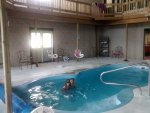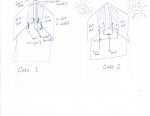Hello,
New pool owner here. Like signature says, I just recently purchased a vacation house with an indoor, inground small pool. The sun does not heat the pool at all since it's indoors, so the heat pump runs all the time if I want to keep the pool above 75 degrees. The ground around the pool is a constant 65, so if I don't run the heater all the time, the pool will be very chilly and unusable. In order to save some money on the energy bill, I was considering either a solar panel type heater on the roof or an attic heater. From what I've read, roof-mounted panels would be the way to go. My only concern is to make sure I get the correct panels and correct controls for trouble-free operation. This is NOT my permanent home, it is a vacation home that I only visit on weekends during summer, and every other week or so the rest of the year; so if the system develops a leak, I probably won't realize it until it's too late and the pool is completely empty by the pump.
I've seen several solar panels being sold on Ebay and Amazon, such as these: http://www.ebay.com/itm/371300297714?_trksid=p2055119.m1438.l2649&ssPageName=STRK:MEBIDX:IT, however, I'm not sure if a flexible, roll-up type of panel is the way to go; they seem flimsy to me. Are there any heavier-duty panels available that are durable but won't make this project cost-prohibitive?
Any suggestions?
Thanks in advance for any advice you can give me for my setup.

John
New pool owner here. Like signature says, I just recently purchased a vacation house with an indoor, inground small pool. The sun does not heat the pool at all since it's indoors, so the heat pump runs all the time if I want to keep the pool above 75 degrees. The ground around the pool is a constant 65, so if I don't run the heater all the time, the pool will be very chilly and unusable. In order to save some money on the energy bill, I was considering either a solar panel type heater on the roof or an attic heater. From what I've read, roof-mounted panels would be the way to go. My only concern is to make sure I get the correct panels and correct controls for trouble-free operation. This is NOT my permanent home, it is a vacation home that I only visit on weekends during summer, and every other week or so the rest of the year; so if the system develops a leak, I probably won't realize it until it's too late and the pool is completely empty by the pump.
I've seen several solar panels being sold on Ebay and Amazon, such as these: http://www.ebay.com/itm/371300297714?_trksid=p2055119.m1438.l2649&ssPageName=STRK:MEBIDX:IT, however, I'm not sure if a flexible, roll-up type of panel is the way to go; they seem flimsy to me. Are there any heavier-duty panels available that are durable but won't make this project cost-prohibitive?
Any suggestions?
Thanks in advance for any advice you can give me for my setup.

John






